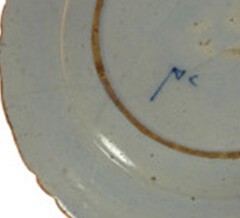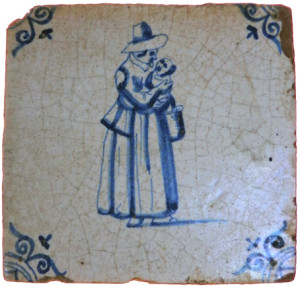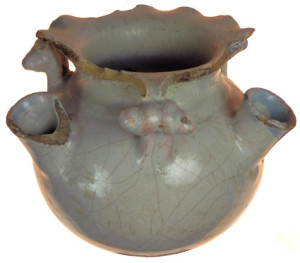Situated in the Museum’s ‘Apothecary Shoppe’ display, can be found several items of iconic blue and white Dutch Delft pottery. Careful research has uncovered some interesting history to share from the examples that we have in our collection.

Research has been carried out on three of our Dutch Delft items. One is an attractive plate with sprays of flowers (1739-1750) and another is a fruit (or strawberry) strainer dish (c.1725-1775) that usually pairs with a matching plate on a table to catch the moisture from strawberries or other soft fruits. The third item is a 17th century Delft tile with an endearing depiction of a mother and child.
In the case of our plate and fruit strainer dish we are fortunate to have evidence of the factory mark on their reverse side. The axe mark shows that both of these items were produced at the earthenware factory, De Porceleyn Bijl (The Porcelain Axe) whose workshop was active from 1657 to 1803.

The mark of the porcelain axe (or hatchet) on De Porceleyn Bijl pottery was established by Hubrecht Brouwer in 1679 and was used by J. Brouwer in 1759 and Hugo Brouwer in 1776. There is written record of Justus Brouwer registering the mark in 1764 when it was made compulsory to do so by the Guild of St. Luc (the Patron Saint of Artists) in that year. As we can see the factory was operated by the Brouwer family for several generations before it closed.

It is interesting to note that even though Dutch products were often referred to as ‘porcelain’, they were in fact tin-glazed earthenware. The fine Chinese porcelain was made from high fired white ceramics made predominantly of clay rich in kaolin in the north; porcelain stone was the main material in Southern China.
The other item on display is our Dutch Delft tile (1650-1655) in the traditional white with a blue central hand-painted figure of a mother or nurse with shopping basket and carrying an infant. The corner scrolls depicted are of the “ox-head” design which was often used, with slight differences, by many individuals or factories.

In 1647 in the Netherlands, at the cessation of the Chinese (and Japanese) porcelain export trade to Europe, local potteries experienced a surge of expansion and success. Chief among these were the workshops in Delft; the blue and white tin-glazed earthenware plaques, dishes, and ornamental objects produced in that city often emulated Chinese models in design and motif.
The seventeenth century is rightly referred to as a Golden Age of Dutch art. Schools of painting arose in cities such as Amsterdam, Delft, Haarlem, Utrecht, and Dordrecht, where a variety of genres were developed and the production of decorative arts flourished. Civic bodies and wealthy lay citizens, including merchants who made their fortunes in Holland’s vast overseas trade empire, were key patrons.
However, by the eighteenth century the Low Countries, exhausted by the intermittent wars for political independence and trading rights of the previous century, slip from cultural prominence and wealth. Rival countries England and France meanwhile rise to great political power and economic strength, and are the seat of major intellectual developments that give rise to the Enlightenment and the Neoclassical movement in the arts and architecture.
British Delftware
It was during the declining economic climate in the Low Countries, that the technique that had been copied from the Chinese and Japanese by the Dutch and used for centuries, was then copied in England and Delftware began to be made at Bristol, London, Dublin, Glasgow and Liverpool.
We have an example of British Delftware on display here at the Abbey Museum. Our little Delftware flower vase was made in one of the many potteries that flourished in London.

This photo of our somewhat damaged vase is very similar to a vase (almost as damaged) currently in the Museum of London. While we think ours came from Lambeth, their vase was found during the archaeological dig of a pottery factory with the most colourful name of the Pickleherring Pothouse, in Southwark c.1618-1723.
There is no doubt that throughout the years Dutch Delft has managed to retain it’s aura of authenticity. Collectors and tourists still flock to the city of Delft to see originals in museums; purchase pieces at auctions for their collections; or buy mass-produced modern replicas.
We are extremely fortunate to have these authentic pieces of16th and 18th century Dutch Delft on display. Visit us at the Abbey Museum to enjoy these and a few more of the ‘unexpected treasures’ we have in the Abbey Museum.

